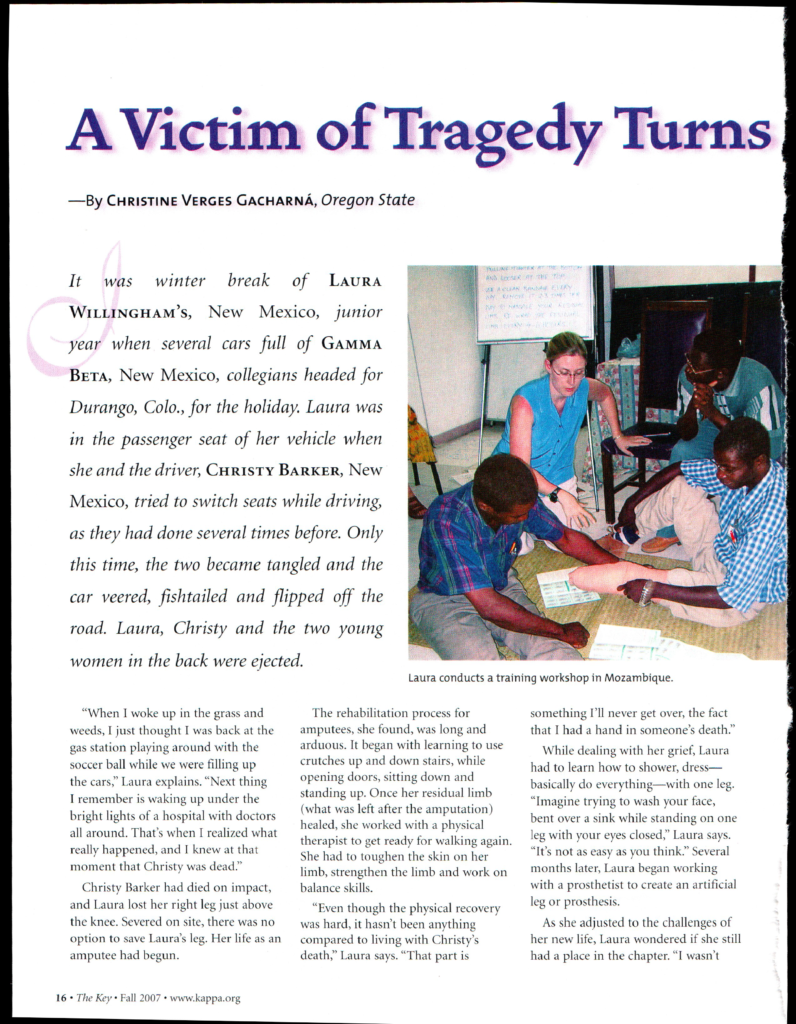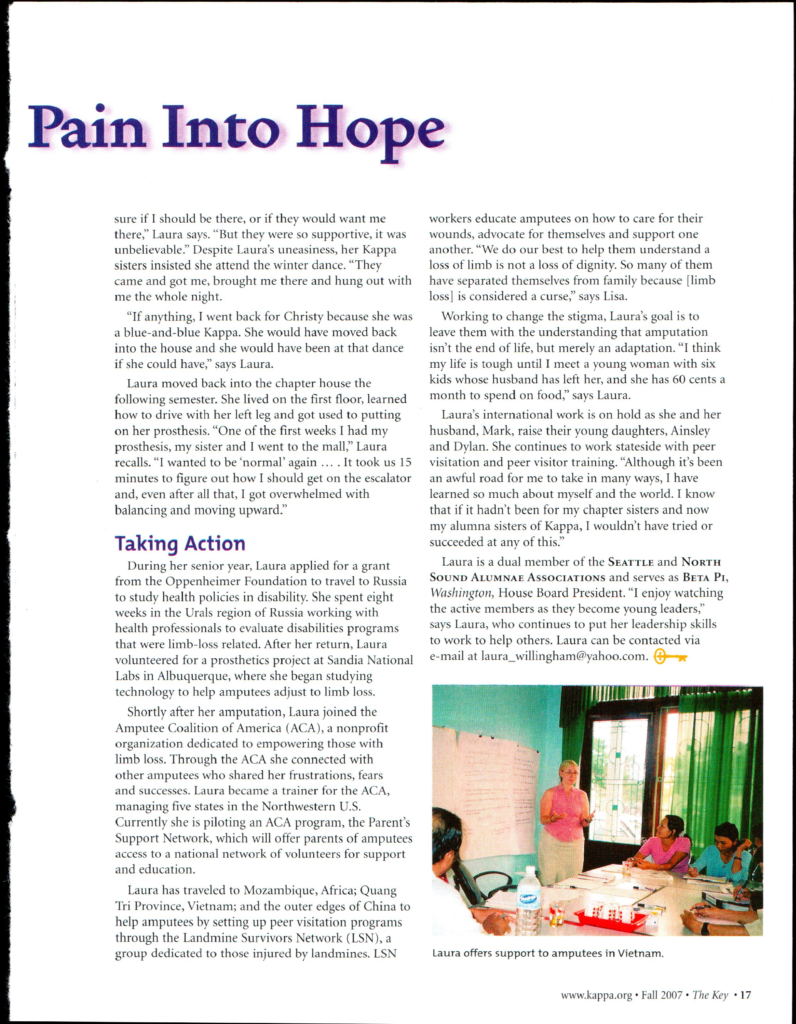A Victim of Tragedy Turns Pain into Hope
It was winter break of Laura Willingham’s, New Mexico, junior year when several cars full of Gamma Beta, New Mexico, collegians headed for Durango, Colo., for the holiday. Laura was in the passenger seat of her vehicle when she and the driver, Christy Barker, New Mexico, tried to switch seats while driving, as they had done several times before. Only this time, the two became tangled and the car veered, fishtailed, and flipped off the road. Laura, Christy, and the two young women in the back were elected.
“When I woke up in the grass and weeds, I just thought I was back at the gas station playing around with the soccer ball while we were filling up the cars,” Laura explains. “Next thing I remember is waking up under the bright lights of a hospital with doctors all around. That’s when I realized what really happened, and I knew at that moment that Christy was dead.”
Christy Barker died on impact, and Laura lost her right leg just above the knee. Severed on site, there was no option to save Laura’s leg. Her life as an amputee had begun.
The rehabilitation process for amputees, she found, was long and arduous. It began with learning to use crutches up and down stairs, while opening doors, sitting down, and standing up. Once her residual limb (what was left after the amputation) healed, she worked with a physical therapist to get ready for walking again. She had to toughen the skin on her limb, strengthen the limb, and work on balance skills.
“Even though the physical recovery was hard, it hadn’t been anything compared to living with Christy’s death,” Laura says. “That part is something I’ll never get over, the fact that I had a hand in someone’s death.”
While dealing with her grief, Laura had to learn how to shower, dress — basically do everything — with one leg. “Imagine trying to wash your face, bend over a sink while standing on one leg with your eyes closed,” Laura says. “It’s not as easy as you think.” Several months later, Laura began working with a prosthetist to create an artificial leg or prosthesis.
As she adjusted to the challenges of her new life, Laura wondered if she still had a place in the chapter. “I wasn’t sure if I should be there, or if they would want me there,” Laura says. “But they were so supportive, it was unbelievable.” Despite Laura’s uneasiness, her Kappa sisters insisted she attend the winter dance. “They came and got me, brought me there, and hung out with me the whole night.
“If anything, I went back for Christy because she was a blue-and-blue Kappa. She would have moved back into the house and would have been at that dance if she could have,” says Laura.
Laura moved back into the chapter house the following semester. She lived on the first floor, learned how to drive with her left leg, and got used to putting on her prosthesis. “One of the first weeks I had my prosthesis, my sister and I went to the mall,” Laura recalls. “I wanted to be ‘normal’ again. … It took us 15 minutes to figure out how I should get on the escalator and, even after all that, I got overwhelmed with balancing and moving upward.”
Taking Action
During her senior year, Laura applied for a grant from the Oppenheimer Foundation to travel to Russia to study health policies in disability. She spent eight weeks in the Urals region of Russia working with health professionals to evaluate disabilities programs that were limb-loss related. After her return, Laura volunteered for a prosthetics project at Sandia National Labs in Albuquerque, where she began studying technology to help amputees adjust to limb loss.
Shortly after her amputation, Laura joined the Amputee Coalition of America (ACA), a nonprofit organization dedicated to empowering those with limb loss. Through the ACA she connected with other amputees who shared her frustrations, fears and successes. Laura became a trainer for the ACA, managing five states in the Northwestern U.S.
Currently she is piloting an ACA program, the Parent’s Support Network, which will offer parents of amputees access to a national network of volunteers for support and education.
Laura has traveled to Mozambique, Africa; Quang Tri Province, Vietnam; and the outer edges of China to help amputees by setting up peer visitation programs through the Landmine Survivors Network (LSN), a group dedicated to those injured by landmines. LSN workers educate amputees on how to care for their wounds, advocate for themselves, and support one another. “We do our best to help them understand a loss of limb is not a loss of dignity. So many of them have separated themselves from family because [limb loss] is considered a curse.”
Working to change the stigma, Laura’s goal is to leave them with the understanding that amputation isn’t the end of life, but merely an adaptation. “I think my life is tough until I meet a young woman with six kids whose husband has left her, and she has 60 cents a month to spend on food,” says Laura.
Laura’s international work is on hold as she and her husband, Mark, raise their young children, Ainsley and Dylan. She continues to work stateside with peer visitation and peer visitor training. “Although it’s been an awful road for me to take in many ways, I have learned so much about myself and the world. I know that if it hadn’t been for my chapter sisters and now my alumnae sisters of Kappa, I wouldn’t have tried or succeeded at any of this.”
Laura is a dual member of the Seattle and North Sound Alumnae Associations and serves as Beta Pi, Washington, House Board president. “I enjoy watching the active members as they become young leaders,” says Laura, who continues to put her leadership skills to work to help others.

